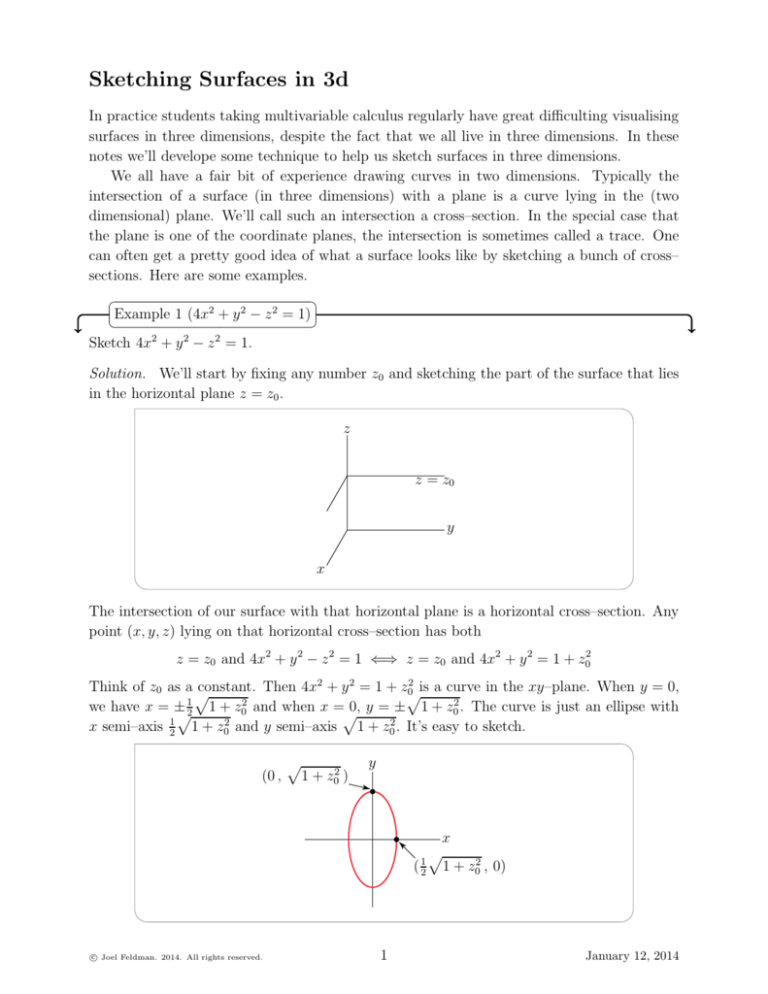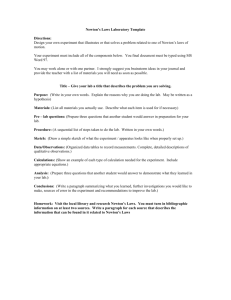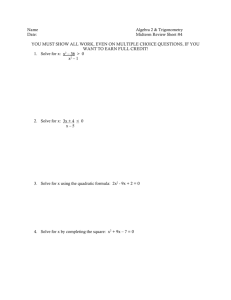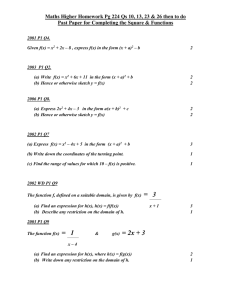
Sketching Surfaces in 3d
In practice students taking multivariable calculus regularly have great difficulting visualising
surfaces in three dimensions, despite the fact that we all live in three dimensions. In these
notes we’ll develope some technique to help us sketch surfaces in three dimensions.
We all have a fair bit of experience drawing curves in two dimensions. Typically the
intersection of a surface (in three dimensions) with a plane is a curve lying in the (two
dimensional) plane. We’ll call such an intersection a cross–section. In the special case that
the plane is one of the coordinate planes, the intersection is sometimes called a trace. One
can often get a pretty good idea of what a surface looks like by sketching a bunch of cross–
sections. Here are some examples.
Example 1 (4x2 + y 2 − z 2 = 1)
Sketch 4x2 + y 2 − z 2 = 1.
Solution. We’ll start by fixing any number z0 and sketching the part of the surface that lies
in the horizontal plane z = z0 .
z
z = z0
y
x
The intersection of our surface with that horizontal plane is a horizontal cross–section. Any
point (x, y, z) lying on that horizontal cross–section has both
z = z0 and 4x2 + y 2 − z 2 = 1 ⇐⇒ z = z0 and 4x2 + y 2 = 1 + z02
2
Think of z0 as a p
constant. Then 4x2 + y 2 = 1 + zp
0 is a curve in the xy–plane. When y = 0,
1
1 + z02 and when x =p
0, y = ± 1 + z02 . The curve is just an ellipse with
we have x = ±
2
p
x semi–axis 21 1 + z02 and y semi–axis 1 + z02 . It’s easy to sketch.
(0 ,
p
1 + z02 )
y
x
p
( 21 1 + z02 , 0)
c Joel Feldman. 2014. All rights reserved.
1
January 12, 2014
Remember that this ellipse is the part of our surface that lies in the plane z = z0 . Imagine
that the sketch of the ellipse is on a single sheet of paper. Lift the sheet of paper up, rotate
it around so that the x– and y–axes point in the directions of the three dimensional x– and
y–axes and place the sheet of paper into the three dimensional sketch at height z0 . This gives
a single horizontal ellipse in 3d, as in the figure below.
z
z = z0
y
x
The full surface consists of many of these horizontal ellipses — one for each possible height
z0 . Our surface is a stack of horizontal ellipses. So draw a few of them as in the figure below.
To reduce the amount of clutter in the sketch, only the first octant (i.e. the part of three
dimensions that has x ≥ 0, y ≥ 0 and z ≥ 0) has been drawn.
z
z=3
z=2
z=1
y
x
Here is why it is OK, in this case, to just sketch the first octant. Replacing x by −x
in the equation 4x2 + y 2 − z 2 = 1 does not change the equation. That means that a point
(x, y, z) is on the surface if and only if the point (−x, y, z) is on the surface. So the surface
is invariant under reflection in the yz–plane. Similarly, the equation 4x2 + y 2 − z 2 = 1 does
not change when y is replaced by −y or z is replaced by −z. Our surface is also invariant
reflection in the xz– and yz–planes. Once we have the part in the first octant, the remaining
octants can be gotten simply by reflecting about the coordinate planes.
We can get a more visually meaningful sketch by adding in some vertical cross–sections.
The x = 0 and y = 0 cross–sections (also called traces — they are the parts of our surface
that are in the yz– and xz–planes, respectively) are
x = 0, y 2 − z 2 = 1
c Joel Feldman. 2014. All rights reserved.
and
2
y = 0, 4x2 − z 2 = 1
January 12, 2014
They are both hyperbolae. We’ll first sketch them in 2d. Since
y2 = 1 + z2
2
4x = 1 + z
2
=⇒
=⇒
|y| ≥ 1
|x| ≥
and
1
2
and
y = ±1 when z = 0
x=
± 12
and for large z, y ≈ ±z
when z = 0 and for large z, x ≈ ± 12 z
the sketchs are
z
z
z=y
4x2 − z 2 = 1
y2 − z2 = 1
x
y
Now we’ll incorporate them into the 3d sketch. Once again imagine that each is a single
sheet of paper. Pick each up and move it into the 3d sketch, carefully matching up the axes.
The red (blue) parts of the hyperbolas above become the red (blue) parts of the 3d sketch
below (assuming of course that you are looking at this on a colour screen).
z
z=3
z=2
z=1
y
x
Now that we have a pretty good idea of what the surface looks like we can clean up and
simplify the sketch. Here are a couple of possibilities.
c Joel Feldman. 2014. All rights reserved.
3
January 12, 2014
z
y
x
This type of surface is called a hyperboloid of one sheet.
Example 1
Example 2 (yz = 1)
Sketch the surface yz = 1.
Solution. This surface has a special property that makes it relatively easy to sketch. There
are no x’s in the equation yz = 1. That means that if some y0 and z0 obey y0 z0 = 1, then
the point (x, y0 , z0 ) lies on the surface yz = 1 for all values of x. As x runs from −∞ to ∞,
the point (x, y0 , z0 ) sweeps out a straight line parallel to the x–axis. So the surface yz = 1
is a union of lines parallel to the x–axis. It is invariant under translations parallel to the
x–axis. To sketch yz = 1, we just need to sketch its intersection with the yz–plane and then
translate the resulting curve parallel to the x–axis.
We’ll start with a sketch of the hyperbola yz = 1 in two dimensions.
z
yz = 1
y
Next we’ll move this 2d sketch into the yz–plane, i.e. the plane x = 0, in 3d, except that
we’ll only draw in the part in the first octant.
c Joel Feldman. 2014. All rights reserved.
4
January 12, 2014
z
y
x
The we’ll draw in x = x0 cross–sections for a couple of more values of x0
z
y
x
and clean up the sketch a bit
z
y
x
Example 2
Often the reason you are interested in a surface in 3d is that it is the graph z = f (x, y) of
a function of two variables f (x, y). Another good way to visualize the behaviour of a function
f (x, y) is to sketch what are called its level curves. By definition, a level curve of f (x, y) is
a curve whose equation is f (x, y) = C, for some constant C. It is the set of points in the
c Joel Feldman. 2014. All rights reserved.
5
January 12, 2014
xy–plane where f takes the value C. Because it is a curve in 2d, it is usually easier to sketch
than the graph of f . Here are a couple of examples.
Example 3 (f (x, y) = x2 + 4y 2 − 2x + 2)
Sketch the level curves of f (x, y) = x2 + 4y 2 − 2x + 2.
Solution. Fix any real number C. Then, for the specified function f , the level curve
f (x, y) = C is the set of points (x, y) that obey
x2 + 4y 2 − 2x + 2 = C ⇐⇒ x2 − 2x + 1 + 4y 2 + 1 = C
⇐⇒ (x − 1)2 + 4y 2 = C − 1
Of course (x − 1)2 + 4y 2 is always at least zero. So if C − 1 < 0, i.e. if C < 1, there is no
curve f (x, y) = C. If C − 1 = 0, i.e. if C = 1, then f (x, y) = C = 1 if and only if both
(x − 1)2 = 0 and 4y 2 = 0 and so consists of the single point (1, 0). If C > 1, then f (x, y) = C
is an ellipse. It intersects the x–axis when y = 0 and
√
√
(x − 1)2 = C − 1 ⇐⇒ x − 1 = ± C − 1 ⇐⇒ x = 1 ± C − 1
and it intesects the y–axis when x = 0 and
√
√
4y 2 = C − 1 ⇐⇒ 2y = ± C − 1 ⇐⇒ y = ± 21 C − 1
√
So, when C > 1, f (x, y) = C is the ellipse centred on (1, 0) with x semi–axis C − 1 and
√
y semi–axis 21 C − 1. Here is a sketch of some representative level curves of f (x, y) =
x2 + 4y 2 − 2x + 2.
y
1
f =1
1
f =2
f =5
f =10
f =17
x
Example 3
c Joel Feldman. 2014. All rights reserved.
6
January 12, 2014
Example 4 (ex+y+z = 1)
The function f (x, y) is given implicitly by the equation ex+y+z = 1. Sketch the level curves
of f .
Solution. Fix any real number C. That “f (x, y) is given implicitly by the equation ex+y+z =
1” means that, for each x, y, the solution z of ex+y+z = 1 is f (x, y). So, for the specified
function f , the level curve f (x, y) = C is the set of points (x, y) that obey
ex+y+C = 1 ⇐⇒ x + y + C = 0
⇐⇒ x + y = −C
This is of course a straight line. It intersects the x–axis when y = 0 and x = −C and it
intesects the y–axis when x = 0 and y = −C. Here is a sketch of some representative level
curves.
y
1
f =−3
x
1
f =−2
f =−1
f =3
f =2
f =1
f =0
Example 4
c Joel Feldman. 2014. All rights reserved.
7
January 12, 2014







